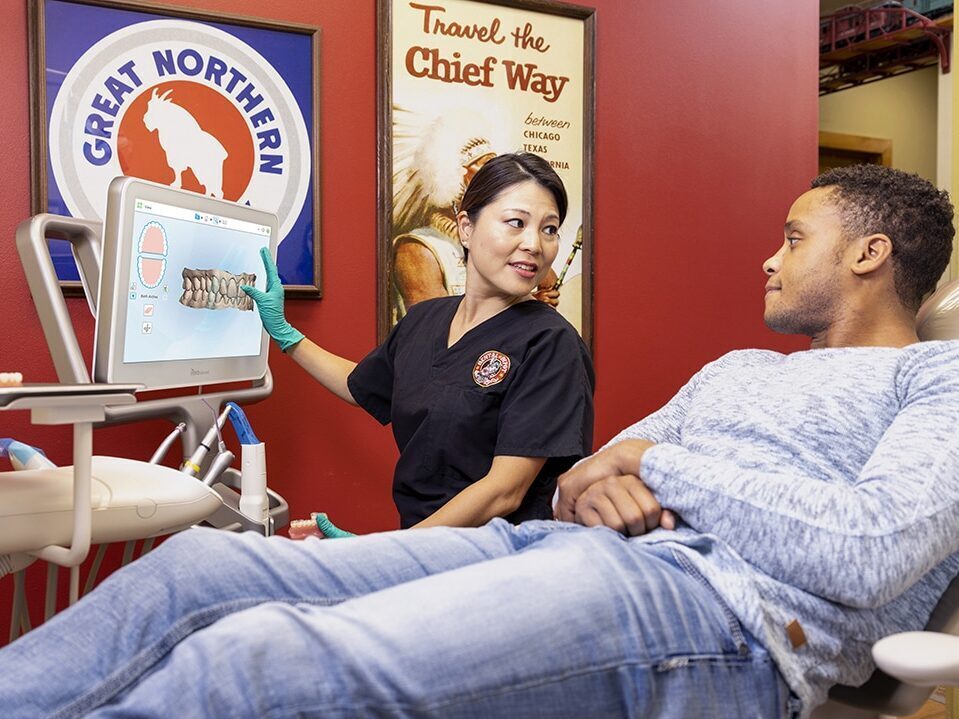Although the primary goal of all dental care is to preserve natural teeth, there are times when a tooth–or multiple teeth–needs to be pulled due to decay, trauma, disease, or developmental concerns. Dental extractions are procedures a dentist, specialist, or oral surgeon performs to remove an entire tooth from its socket and surrounding tissue.
Dental extractions are typically the last resort. Suppose that is the recommended course of action. In that case, it’s probably because removing the tooth is necessary to protect the patient’s overall health and facilitate the next steps required for proper treatment, healing, or development. If a tooth that needs to be removed is not, any decay or infection within it can spread to other teeth, oral tissue, and the jaw bone. The tooth will likely eventually fall out, leaving the mouth and remaining teeth susceptible to further infection and bone deterioration.

At Dental Depot Oklahoma, we know tooth extractions can be intimidating, no matter why they’re happening. If you need a tooth extracted, you can trust the caring, compassionate, and professional staff at Dental Depot Oklahoma to provide you with the information and resources to understand why you need the extraction as well as to explain what exactly will happen and how to make your recovery as successful as possible.
Though some tooth extractions are unavoidable, many more are preventable with good oral health and routine dental cleanings and checkups.
With comprehensive preventative and restorative dentistry from Dental Depot Oklahoma, everyone in your family can receive the quality, affordable services they need at multiple locations across the state, including OKC, Norman, and Tulsa, many with flexible hours and Saturday appointments.
At Dental Depot Oklahoma, we believe all Oklahomans deserve exceptional dental care at a commonsense price. Schedule your appointment today and discover your healthiest and most confident smile!
Simple tooth extractions are performed on teeth that are visible and easily accessible in the mouth. Simple tooth extractions do not require an incision and are performed under local anesthetic.
LEARN MORE ABOUT:
Wisdom Teeth Removal
Surgical tooth extractions require an oral surgeon and are usually necessary for more complicated situations, which may include:
The actual process of extracting a tooth should not hurt. Before the procedure, the dentist will administer anesthesia to numb or dull your mouth and gums, so while you may feel some pressure or be awake during your procedure, you should not feel any pain. The type of extraction will determine what type of anesthesia you need. A simple extraction may only require a local numbing agent while a more complex wisdom tooth removal might require something like nitrous oxide.
You might experience some tenderness or soreness afterwards, but usually, these side effects can be managed with over the counter pain medication, or you may receive a prescription for pain medication from your dentist. Often, the pain of the tooth that needs to be pulled is worse than the extraction itself and is relieved once the tooth is removed.
A dentist might recommend a tooth extraction for a variety of reasons such as:
While your circumstance will determine the severity of the risk of not having your tooth extracted, it’s important to realize that, in most cases, removing a tooth is the absolute last resort. Your dentist will do everything he or she can to save a tooth and avoid an extraction, but if that is what is being recommended, your health may be at risk if you do not have it removed. Your dentist will walk you through any risks or concerns when advising you on your particular decision to have your tooth extracted.
If you do not have the infected tooth removed, there is the risk of infection as well as the potential concern that the infection could spread to your gums, jaw bone, or your body more generally. There is potentially a risk for bone loss in the jaw or facial bones, loss of teeth, or improper development and alignment in children.
After your tooth extraction, your dentist will provide you with a detailed list of at-home care instructions, including what foods are best to eat in the hours following your procedure. Eating the right foods will expedite the healing process and help you avoid unnecessary additional pain. Usually soft foods and liquids are best (ice cream, soup, applesauce, bread, muffins, pudding, yogurt, etc.). Since you may be uncomfortable or unable to drive after your procedure, you may consider shopping before your tooth extraction to ensure you have the necessary foods at home, helping you comply with your dentist’s recommendations and avoiding complications.
It is normal to experience some discomfort for several days after a tooth extraction. You try the following measures to help you minimize the discomfort, pain, or swelling:
It is also normal–and often necessary–for a blood clot to form over the extraction site. However, if the blood clot does not form or if the bone inside the pocket becomes exposed, you can develop what is called a “dry socket,” which is very painful and will require the dentist to put a dressing over the extraction site.
Unusual side effects from a tooth extraction that require medical attention include:
Call your dentist or seek medical attention if you experience any of the above symptoms or any others that may be listed in your procedure discharge notes.
Decay or infection. The most common reason for tooth extraction is dental decay. If a tooth has become infected and has gone untreated for an extended period, or if minor decay like cavities has not been addressed, the decay and infection can spread, making the tooth unsalvageable.
Gum disease. When left untreated, periodontal (gum) disease is just as harmful to the tooth as a severe infection within the tooth itself. With the degeneration of the soft connective tissues, the ligaments and bone supporting the teeth become compromised, causing the tooth to loosen in the socket and exposing the tooth root to infection.
Failure to erupt. A tooth that is impacted–or has not erupted–is essentially stuck and unable to break through the gum because of overcrowding, being twisted at an odd angle, or because it has entangled or curved roots. Wisdom teeth, also called third molars, are among the most common teeth that become impacted and require extraction because the jaw is not large enough to accommodate them.
Overcrowding. Tooth extraction may be necessary for a patient’s orthodontic plan, especially for baby or deciduous teeth. For some patients, removing one or more teeth will make metal braces or alignment trays more effective because additional space is provided to straighten the teeth and allow adult teeth to erupt and develop properly.
Trauma. Trauma or damage to areas of the teeth beneath the gum line can leave the tooth too compromised to save. Because the cracked or fractured portion of the tooth is not visible, it can’t be repaired with a dental crown and may require extraction.
There are two types of extraction methods, surgical and simple. The type of extraction necessary depends on various factors, such as the size and location of the tooth and the extent of the damage or decay. Many dentists at Dental Depot Oklahoma can perform simple and certain types of surgical teeth extractions. Our staff includes other oral specialists and surgeons who can perform more complex extractions.
Simple Extraction. A simple extraction involves removing a tooth that is visibly exposed above the gum line and doesn’t require any connective or oral tissue to be cut.
Here’s what happens during a simple extraction:
Surgical extraction. A surgical extraction involves the removal of teeth that are not visible or accessible. The tooth may be hidden, broken, or fractured beneath the gum line, so the gum must be cut open to expose the tooth. Some surgical extractions require an oral surgeon using general anesthesia in a hospital setting. Others may be performed by a general dentist and require only local anesthesia combined with laughing gas.
In general, here is what happens during a surgical extraction:
Regardless of the extraction method, speaking with your dentist about replacing the tooth or teeth as soon as possible is important. Leaving a gap in your teeth can cause other teeth to shift, putting your jaws out of alignment and causing the bone in your jaw to deteriorate.
If a tooth requires extraction, it is usually necessary for the patient’s overall health. But it’s important to note that while removing the tooth may fix one problem, you’ll need to be aware of some common side effects of tooth extraction.
Dry socket. After the extraction, a blood clot generally forms in the empty socket. This provides a protective barrier for the exposed bone and nerve endings. If the clot fails to develop or is dislodged before the wound is healed, the result can be a painful dry socket that exposes the nerves and can compromise healing. Your dentist or oral surgeon will provide detailed instructions on caring for your extraction site and what to look for if there is a problem.
Misalignment. When new space is opened up in the mouth, it is normal for the remaining teeth to begin to shift. Occasionally, as in the case of orthodontic treatment, this is part of the intended result. In other situations, however, the gap could cause unintended realignment, affecting your bite, jaw function, and the integrity of your remaining natural teeth.
